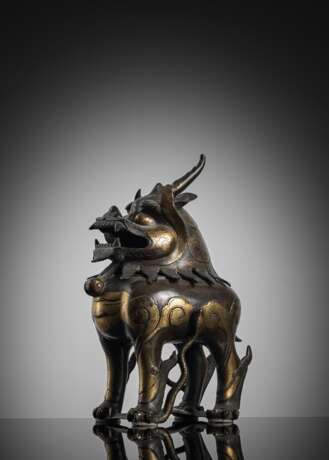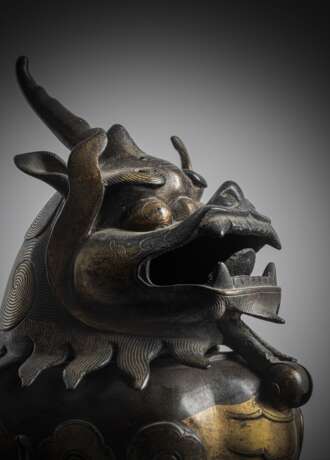ID 1215665
Lot 263 | Feiner partiell feuervergoldeter Weihrauchbrenner aus Bronze in Form eines Luduan
Estimate value
€ 2 500 – 3 500
H. 24,2 cm
Das Fabelwesen ist fein gegossen und steht auf vier Füßen, wobei es eine Schlange umklammert, die sich im Zickzack über seine Füße schlängelt. Der einhörnige Kopf ist von vorne aufklappbar und mit gewölbten Augen und gefletschten Zähnen gegossen. Der Körper ist mit wirbelnden, vergoldeten Schnörkeln verziert, und die Mähne ist fein graviert. Gewicht: 1,431 kg
Sammlung des Würzburger Malers Joachim Schlotterbeck (1926-2007), versteigert Nagel, 6.5.1995, Los 121 und erworben vom heutigen Besitzer
Luduan sind mythische und verheißungsvolle Wesen mit starkem Löwenkörper, einem einzigen Horn und den Pfoten eines Bären. Ihnen wird die Fähigkeit zugeschrieben, große Entfernungen zu überwinden, alle Sprachen zu beherrschen, die Zukunft vorherzusagen, dem Guten Leben zu schenken und das Böse zu töten. Der Legende nach waren sie ursprünglich als "jiaoduan" bekannt und wurden dann in "luduan" umbenannt, weil das Schriftzeichen für "lu" besser zu ihrem Aussehen passte. Als Beschützer erleuchteter Herrscher erschienen die luduan in Gegenden, in denen ein weiser und tugendhafter Führer anwesend war. Die verheißungsvolle Natur der luduan war für den Zweck dieser Räuchergefäße besonders geeignet. Sie wurden mit klappbaren oder abnehmbaren Köpfen gegossen und dienten zum Verbrennen von Weihrauch, wobei Rauch aus dem Maul des Tieres aufstieg und die Skulptur belebte und stärkte. Wie Chuimei Ho und Bennet Bronson in ihrer Besprechung eines Paares von Qianlong-Cloisonné-Emaillexemplaren aus dem Palastmuseum in Peking feststellen, die in der Ausstellung Splendors of China's Forbidden City. The Glorious Reign of Emperor Qianlong, The Field Museum, Chicago, 2004, zu sehen sind, wurden diese Brenner am kaiserlichen Hof traditionell sehr geschätzt, da sie mit ihren offenen Mündern und dem ausströmenden Rauch den Kaiser daran erinnerten dass er für ehrliche Ratschläge stets offen sein sollte (siehe S. 37). Der Ursprung von Räuchergefäßen dieser Form ist schwer zu bestimmen; ein Beispiel, das der Song-Dynastie zugeschrieben wird, wurde aus dem Grab des Gelehrten und Beamten Zhang Shupei (1552-1615) aus der Ming-Dynastie in Tonglian, Sichuan, geborgen (Wenwu, 1989, Nr. 7, S. 45-46, Abb. 14-16). Räuchergefäße mit mythischen Tieren wurden jedoch erst ab der Xuande-Zeit zu einem beliebten Modell. Ein Räuchergefäß in Form eines mythologischen Tieres findet sich auf dem Gemälde "Enjoying Antiquities" von Du Jin (ca. 1467-1505), auf dem zwei Gelehrte dargestellt sind, die eine Auswahl von Altertümern begutachten (abgebildet in Through the Prism of the Past: Antiquarian Trends in Chinese Art of the 16th to 18th Century, National Palace Museum, Taipei, 2003, Kat. I-44). Eine Zeichnung eines ähnlichen Tieres ist auch im Shizu zhai jian pu (Ten Bamboo Studio Catalogue of Letter Paper Designs) veröffentlicht, einem Holzschnittbuch mit Briefpapier aus dem Jahr 1645, zusammengestellt von Hu Zhengyan und abgebildet in Ip Yee und Laurence C.S. Tam, Chinese Bamboo Carving, Bd. 1, Hong Kong, 1978, S. 179, Abb. 15. Ihre Beliebtheit hielt bis weit in die Kangxi-Herrschaft an, als Zensoren dieser Form in einer Vielzahl von Medien hergestellt wurden, darunter Porzellan, Cloisonné-Email und Bronze. Ein Prototyp dieser Form aus der Xuande-Periode wurde bei Sotheby's Hongkong verkauft, das erste aus der Sammlung Water, Pine and Stone Retreat, 8.4.2014, Lot 233, und das zweite, 8.10.2014, Lot 3759. Ein sehr ähnliches Gefäß wurde bei Christie's London, 6.11.2018, Lot 91 verkauft - Der Deckel mit kleinen Bestoßungen an den Spitzen der Mähne und kleinem Verlust am Scharnier
| Address of auction |
Nagel Auktionen GmbH Neckarstrasse 189 - 191 70190 Stuttgart Germany | ||||||||||||||
|---|---|---|---|---|---|---|---|---|---|---|---|---|---|---|---|
| Preview | |||||||||||||||
| Phone | +49 (0)711 649 690 | ||||||||||||||
| Fax | +49 (0)711 649 69696 | ||||||||||||||
| Buyer Premium | 29,5% | ||||||||||||||
| Conditions of purchase | Conditions of purchase | ||||||||||||||
| Business hours | Business hours
|




